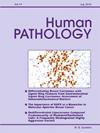Mucinous tubular and spindle cell carcinoma with papillae: A report of 5 cases and comparison with 18 cases of papillary renal cell carcinoma
IF 2.6
2区 医学
Q2 PATHOLOGY
引用次数: 0
Abstract
As its descriptive name indicates, mucinous tubular and spindle cell carcinoma (MTSCC) is composed of tubules, spindle cells, and extracellular mucinous stroma. Papillary architecture in MTSCC is regarded as infrequent finding and often is described as papillation or pseudopapillary appearance since bona fide papillary structures with fibrovascular cores are not seen. In this study, we report five cases of MTSCC with papillary formation and compare those with 18 cases of former type 1 papillary renal cell carcinoma (PRCC). Chromosomal microarray analysis was performed to confirm the diagnosis. All 5 MTSCC tumors exhibited at least focal papillary formation. However, the fibrovascular cores were generally mucinous with scant cellularity and vessels. In addition, psammoma bodies were observed in two, and foamy macrophages were seen in four cases of MTSCC. All PRCC cases exhibited classical papillary architecture without bland spindled tumor cells. Interestingly, focal mucinous stroma was observed in 7 PRCC (39 %). Foamy macrophages were identified in 15 (83 %), and psammoma bodies in 5 PRCC cases (28 %). The MTSCC had the typical monosomy of multiple chromosomes. However, the trisomy of 7, 17, and loss of Y typically found in PRCC were not observed in any of the 5 MTSCC. In summary, MTSCC and PRCC share many morphological features, including papillary formation, foamy macrophages, psammoma bodies, and mucinous stroma which should be emphasized. These shared features make distinguishing MTSCC from PRCC difficult in a small core biopsy or fine needle aspiration (FNA) specimen. Chromosomal microarray or FISH can be helpful in problematic cases.
肾乳头状细胞癌5例与18例比较。
顾名思义,粘液管状和梭形细胞癌(MTSCC)由小管、梭形细胞和细胞外粘液基质组成。MTSCC的乳头状结构被认为是罕见的发现,通常被描述为乳头状或假乳头状外观,因为没有见过具有纤维血管核心的真正乳头状结构。在本研究中,我们报告了5例合并乳头状形成的MTSCC,并与18例原1型PRCC进行了比较。进行染色体微阵列分析以确认诊断。所有5例MTSCC肿瘤均表现出至少局灶性乳头状形成。然而,纤维血管核心通常是粘液状的,细胞和血管较少。另外,2例MTSCC可见沙粒小体,4例MTSCC可见泡沫状巨噬细胞。所有PRCC病例均表现为典型的乳头状结构,无淡色梭形肿瘤细胞。有趣的是,在7例PRCC(39%)中观察到局灶性粘液间质。泡沫状巨噬细胞15例(83%),沙粒小体5例(28%)。MTSCC具有典型的多染色体单体。然而,在5例MTSCC中均未观察到PRCC中常见的7,17三体和Y缺失。综上所述,MTSCC和PRCC有许多共同的形态学特征,包括乳头状形成、泡沫巨噬细胞、沙粒小体和粘液间质,这些都是值得重视的。这些共同特征使得在小核活检或FNA标本中难以区分MTSCC和PRCC。染色体微阵列或FISH对有问题的病例有帮助。
本文章由计算机程序翻译,如有差异,请以英文原文为准。
求助全文
约1分钟内获得全文
求助全文
来源期刊

Human pathology
医学-病理学
CiteScore
5.30
自引率
6.10%
发文量
206
审稿时长
21 days
期刊介绍:
Human Pathology is designed to bring information of clinicopathologic significance to human disease to the laboratory and clinical physician. It presents information drawn from morphologic and clinical laboratory studies with direct relevance to the understanding of human diseases. Papers published concern morphologic and clinicopathologic observations, reviews of diseases, analyses of problems in pathology, significant collections of case material and advances in concepts or techniques of value in the analysis and diagnosis of disease. Theoretical and experimental pathology and molecular biology pertinent to human disease are included. This critical journal is well illustrated with exceptional reproductions of photomicrographs and microscopic anatomy.
 求助内容:
求助内容: 应助结果提醒方式:
应助结果提醒方式:


